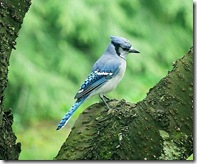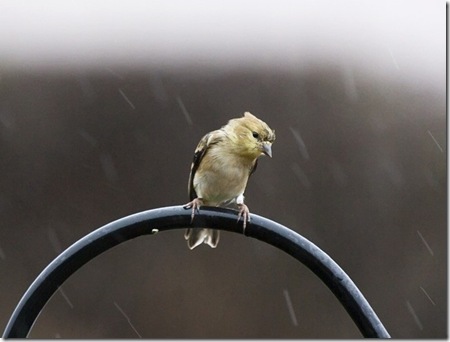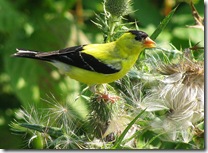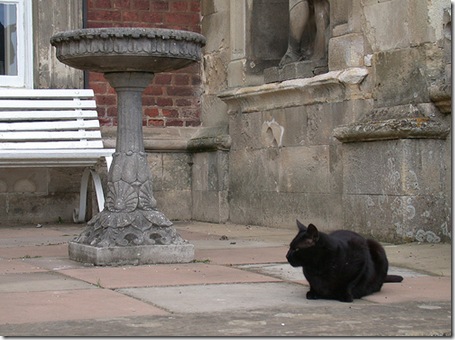Winter interest is the Holy Grail for us gardeners, and we spend an inordinate amount of time planning out which cool foliage plant or winter bloomer we’ll tuck in.
Don’t get me wrong, I’m a sucker for that year-round interest too – but there is another source of excitement during the darker months – birds!
During the growing season, much of the birds’ liveliness is obscured by leaves – we hear rustles and chirrups but can’t quite see what they’re up to. Winter’s bare branches and dormant perennials give us a fantastic view of them scratching at the soil for bugs and seeds, and playing in the shrubbery.
So how do we attract birds in the winter?
Bird feeders:
The winter cold makes the birds need more calories, just at the time of year when there’s less food available.
You can set a feeder under the eaves, or get a weather dome so the seeds don’t mold in the rain.
Try to match your feed to the birds you see in the neighborhood, because bags of mixed seed usually come with filler seed like red millet, oats, milo, or wheat, which nobody really likes (except the raccoons!). Specialty stores have premium mixes with just the good stuff in.
I’ve been thrilled to get goldfinches with a Nyger seed feeder (I call Goldfinches Lemonbirds of Doom because when they are flying, they look like fat little lemons with black wings!). I’ve even considered growing thistles in my garden to make them happy (you can tell I’m a fan!).
White millet is the cheapest seed around and is favored by sparrows, among others, and safflower seeds bring the chickadees.
 People in country settings should try oil sunflower seeds (the black ones without the white stripe, which are highest in calories and least messy), which are good for any number of birds, including bluejays, woodpeckers, chickadees, titmice and nuthatches. I haven’t had any luck with them right in town – the seeds just sit – but feeders that are surrounded by wilder land are enthusiastically emptied!
People in country settings should try oil sunflower seeds (the black ones without the white stripe, which are highest in calories and least messy), which are good for any number of birds, including bluejays, woodpeckers, chickadees, titmice and nuthatches. I haven’t had any luck with them right in town – the seeds just sit – but feeders that are surrounded by wilder land are enthusiastically emptied!
A suet feeder is another way to bring the birds around in winter, particularly in areas that snow, since the cold kills a lot of insects and removes that food source. Check out Aerie-el’s birds loving her home-made suet, and look in the comments for her recipe.
Bird baths:
Water isn’t the toughest resource to find here in rainy Humboldt County, but if it freezes in your neck of the woods, a heated bird bath is a simple way to keep your bird friends coming back to your garden.
In summer, water can attract species of birds that eat fruit and bugs, and so wouldn’t come to your feeder. I love to see the birdies floof up their feathers and flap in the water to get clean!
Birdbaths should be on a pedestal for most birds, no deeper than 3” in the center, and have a rough texture so their footing feels secure. Fountains or baths which splash or sprinkle water are especially attractive and will even lure the hummingbirds in for a drink!
So where do you put your bird bath and feeder so they’ll get used?
Neighborhood cats love the birds’ show as much as we do, so you’ll want to put your feeder and bath someplace open where the birds can see 5-10’ around, so no ambitious felines can sneak up on them. I like to put baths near pathways or lawns, because we usually don’t plant anything too tall near the borders anyway.
Overhanging branches within a few feet are nice too, because then birds can take quick shelter if they are disturbed.
Don’t forget to think about your own enjoyment when placing them! For example, could you put a feeder near the kitchen window so you can watch them while doing dishes?
Lastly, place them close by so they are easy to fill with water or seed.
But hel-lo, this is a gardening blog, can’t I just plant something?
No worries, I’m getting to that! I simply have too many favorite bird-attracting plants to list them all in one post, so in the articles listed below I’ll talk in depth about my number-one picks for birds.
If you’d like to read more, check out the rest of this series below:
Small Shrubs, Grasses, and Perennials to Attract Birds
Nectar Plants to Attract Hummingbirds
Container Plants to Attract Birds
Who visits your garden?
What birds come to your garden, and what do they seem to like best? Tell me in the comments below.



12 responses to “The Winter-Interest Secret Most Gardeners Forget: or How to Attract Birds”
Hi Gen,
Great post. I have been thinking about this a lot and I have been wondering how to attract more birds than what we usually see around here. I love, love, love the Jays. They’re so beautiful and big. I would like to put some kind of squirrel-proof feeder in the yard as well as a bird bath. So many good ideas. I think I’ll be replacing some plants that didn’t make it through the winter so I’m really interested in bird attracting flora. Can’t wait to see your list!!
Hi Genevieve, this is so timely, there is still one more day for the GBBC, great backyard bird count put on by Cornell University and Audobon Society!
http://www.birdsource.org/gbbc/
Do join in!
Frances
Frances’s last blog post..Feb Bloom Day 2009
Hey Genevieve, I am catching up on reading blogs today and saw you linked my suet post–thank you!
Very timely for your post too, since it’s the Great Backyard Bird Count this weekend.
Always a pleasure to read your blog!
~Aerie-el
Aerie-el’s last blog post..RED, WHITE, AND GREEN
I love the photo of the goldfinch; you can almost hear him saying “Bananas!” (or some swaer in bird language) about the blustery weather. I’m participating int he bird count this weekend, too. I think my having fresh water in the garden encourages a lot more of all kinds of wildlife (I saw a duck bathing in it earlier in the month, and the heater didn’t seem to bother her!) than just feeders.
Thanks also for the offer of advice. I’m sure I’ll take you up on that once I get myself a little more organized. My main plan is to write a book and my immediate main plan is to detox a bit from my job!
Monica’s last blog post..Today I Leapt
Iona, I love the Jays, too! I only wish they’d come to my garden, but I haven’t seen them around the neighborhood… The people who have tons of them complain about how raucous they are – but I don’t care! I love to look at their funny-shaped little heads and find their blue feathers in the garden.
And I’m super jealous of anyone with squirrels. I love them too.
I didn’t even know about this bird count – it sounds awesome. I’m going to go check it out right now!
And Monica, I’m sure you’re going to have great success! Bold action is key to achieving your dreams. I’m inspired!
Yes, I so agree! It’s so exciting to watch birds land and enjoy their bath!
I’m thinking of moving apartments and one of the places I looked at had a great patio. I was thinking that it had a perfect spot for a bird bath, so I was looking through my feed reader for bird bath ideas. I don’t know how I missed this post the first time around, but you’ve got some great ideas. Thanks! Of course you know I am really looking forward to your container gardening ideas for attracting birds! 🙂
What a great resource, Genevieve! Thanks for sharing the link to this post, as well as the five others in this series, for the GGW Design Workshop. The plant-focused posts were especially interesting – particularly the one with your suggestions for bird-friendly container plantings. Just goes to show that you can create habitat even in a small space.
[…] The Winter-Interest Secret Most Gardeners Forget (Genevieve at North Coast Gardening): Interesting seedheads, bright bark, and evergreens are all well and good, but don’t overlook the color, sound, and movement that birds can bring to the winter garden. Genevieve offers a number of tips to welcome these winged wonders during the colder months. This post also includes links to five other posts, in which she offers bird-friendly planting suggestions (even for containers!). […]
[…] you’ve been following my series on Planting to Attract Birds, you may already have a few plants in mind to attract hummingbirds to your garden. Who wouldn’t […]
[…] talked earlier this week about how to attract birds using feeders and water. Since we’re all plant geeks here, I’m dying to share some of my […]
[…] Supplemental feeders: birdseed, squirrel food, suet cakes (you can make your own), butterfly and hummingbird feeders are all good ways of supplementing what’s growing in the garden, particularly if your garden is still too young to provide abundant natural food. Feeders are also a good way of bringing wildlife to a specific spot if you like to take photos of them. […]